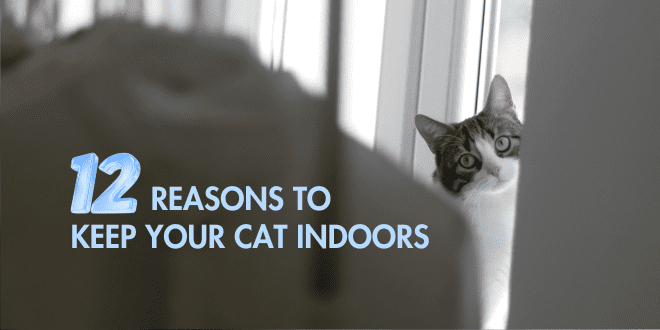
The indoor vs outdoor argument has gone on for years. There are many people who believe it’s cruel or unnatural to confine a cat to indoor living. There are also many people who feel the cat is safe enough outdoors as long as it’s only during the day. People who live in more rural environments or those in particular regions may feel it’s part of the normal way of life to allow cats to roam freely.
Regardless of where you live, there’s no way to ensure your cat will be safe outdoors. Just the fact that cats are not just predators, but also prey, puts them at great risk, and that’s just the beginning. As you’ll see from the list below, there are way too many factors beyond your control.
Cats kept indoors stand a much better chance of living longer. That being said, indoor life isn’t just about setting out food and water, a litter box, a few toys, and then having the cat live a life of boredom. Your indoor cat needs enrichment, training and engagement. To increase the chances of a full, happy, healthy life, a cat needs good nutrition, humane and appropriate training, vertical territory, opportunities to discover and be stimulated, solo playtime, interactive playtime, appealing and clean litter boxes, scratching posts, hiding places, a feeling of safety and security, and the ability to have choice and control in daily life.
If you haven’t given much thought as to how indoor life is safer for cats, are some reasons:
1. Indoor Cats Generally Live Longer
In general, cats who are strictly indoors will live years longer than cats restricted exclusively to the outdoors. If cats have indoor/outdoor access, chances are they’ll live longer than the exclusively outdoor felines but they still face increased risks to health and safety that can impact lifespan.
2. Indoor Cats Won’t Get Struck by Vehicles
The outdoor cat is always at risk of being struck by a vehicle. Even the most supposedly street savvy feline can become distracted while in pursuit of prey or while being chased by another cat or a dog. Cats get hit by cars at an alarmingly high rate and a little eight-pound cat is no match against a car or truck. Even if the cat survives, the injuries are usually extremely severe.
3. Reduced Risk of Cats Being Poisoned
Outdoors cats are at risk of exposure to ethylene glycol (antifreeze) poisoning, lawn pesticides, poisoning from spoiled food in trash cans, mole and rodent poisons, and intentional poisoning from people. Even though there’s a risk of poisoning in an indoor environment as well, you’re better able to remove toxic plants, toxic chemicals, and other dangers in order to keep them out of your cat’s reach.
4. Decreased Risk of Disease to Your Cat
If indoor cats aren’t exposed to other outdoor cats, they have a greatly reduced risk of contracting contagious diseases.
5. Prevent Injury from Animal Fights
It’s not unusual for an outdoor cat to become injured or develop a painful and serious abscess from fighting with another cat, dog or other outdoor animal. Even if you have your cat neutered or spayed, there are many intact cats roaming outside who are extremely territorial and are willing to engage in serious fights.
6. Decreased Risk of parasites to Cats
The chances of your cat becoming infested with fleas, ticks, or internal worms will be greatly reduced in an indoor environment because of the lack of contact with infected feces, prey, grass, or soil.
7. No Danger to Your Cat from Predators
Cats are potential prey to some dogs, and and if you live in certain areas of the country they are also at risk of being attacked by coyotes, owls, mountain lions, or other predators.
8. Being Able to Control Food
With indoor cats you can control nutrition and how much is consumed each day. If your cats go outdoors you have no idea whether they’re munching on some cheap food left out on a neighbor’s back porch for the local stray cats. By eating from that same outdoor food bowl, cats will also be at risk of contracting disease.
9. No Risk of Cruelty Toward Your Cat
Outdoors, your cat may easily become the victim of a cat-hating neighbor, mean people who think it’s fun to abuse a helpless animal, or people who use cats for unspeakable things.
10. You’ll Know Where Your Cat is
Even though indoor cats do escape out of the house or get lost, the risk is of being stolen or lost is greatly reduced. Even indoor cats should have identification though. The most reliable form of identification is to have your cat microchipped.
11. Better Health Monitoring of Your Cat
With an indoor cat you can monitor what is or isn’t happening in the litter box. That early detection of any change in your cat’s litter box habits could mean less pain and suffering. You’ll also be able to better monitor changes in food or water intake, activity level, etc.
12. You’ll be a Better Neighbor
Not everyone wants a cat peeing in their garden, stalking the backyard bird feeder, or lounging on the car in their driveway. In most cases, your neighbors will be happier knowing your cat is quietly watching the outdoor activity from inside the house.
Need More Information?
For more specific information on how to create a fun and safe environment for your cat, refer to the best-selling books by Pam Johnson-Bennett. Pam’s books are available at bookstores and online. We’ve also included Amazon links here on our website.
If you have a question about your cat’s behavior or health, contact your veterinarian. This article is not intended as a medical diagnosis nor is it a replacement for your cat’s regular veterinary care. This article is for general information purposes only.





